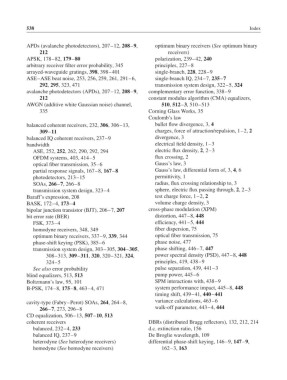Page 557 - Fiber Optic Communications Fund
P. 557
538 Index
APDs (avalanche photodetectors), 207–12, 208–9, optimum binary receivers (See optimum binary
212 receivers)
APSK, 178–82, 179–80 polarization, 239–42, 240
arbitrary receiver filter error probability, 345 principles, 227–8
arrayed-waveguide gratings, 398, 398–401 single-branch, 228, 228–9
ASE–ASE beat noise, 253, 256, 259, 261, 291–6, single-branch IQ, 234–7, 235–7
292, 295, 323, 471 transmission system design, 322–5, 324
avalanche photodetectors (APDs), 207–12, 208–9, complementary error function, 338–9
212 constant modulus algorithm (CMA) equalizers,
AWGN (additive white Gaussian noise) channel, 510, 512–3, 510–513
335 Corning Glass Works, 35
Coulomb’s law
balanced coherent receivers, 232, 306, 306–13, bullet flow divergence, 3, 4
309–11 charges, force of attraction/repulsion, 1–2, 2
balanced IQ coherent receivers, 237–9 divergence, 3
bandwidth electrical field density, 1–3
ASE, 252, 252, 262, 290, 292, 294 electric flux density, 2, 2–3
OFDM systems, 403, 414–5 flux crossing, 2
optical fiber transmission, 35–6 Gauss’s law, 3
partial response signals, 167–8, 167–8 Gauss’s law, differential form of, 3, 4,6
photodetectors, 213–15 permittivity, 1
SOAs, 266–7, 266–8 radius, flux crossing relationship to, 3
transmission system design, 323–4 sphere, electric flux passing through, 2, 2–3
Baraff’s expression, 208 test charge force, 1–2, 2
BASK, 172–4, 173–4 volume charge density, 3
bipolar junction transistor (BJT), 206–7, 207 cross-phase modulation (XPM)
bit error rate (BER) distortion, 447–8, 448
FSK, 373–4 efficiency, 441–5, 444
homodyne receivers, 348, 349 fiber dispersion, 75
optimum binary receivers, 337–9, 339, 344 optical fiber transmission, 75
phase-shift keying (PSK), 385–6 phase noise, 477
transmission system design, 303–305, 304–305, phase shifting, 446–7, 447
308–313, 309–311, 320, 320–321, 324, power spectral density (PSD), 447–8, 448
324–5 principles, 419, 438–9
See also error probability pulse separation, 439, 441–3
blind equalizers, 513, 513 pump power, 445–6
Boltzmann’s law, 95, 101 SPM interactions with, 438–9
B-PSK, 174–8, 175–8, 463–4, 471 system performance impact, 445–8, 448
timing shift, 439–41, 440–441
cavity-type (Fabry–Perot) SOAs, 264, 264–8, variance calculations, 463–6
266–7, 273, 296–8 walk-off parameter, 443–4, 444
CD equalization, 506–13, 507–10, 513
coherent receivers DBRs (distributed Bragg reflectors), 132, 212, 214
balanced, 232–4, 233 d.c. extinction ratio, 156
balanced IQ, 237–9 De Broglie wavelength, 109
heterodyne (See heterodyne receivers) differential phase-shift keying, 146–9, 147–9,
homodyne (See homodyne receivers) 162–3, 163

